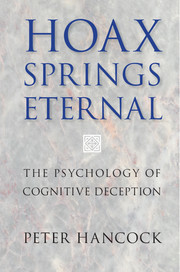I - The Tangled Web
Published online by Cambridge University Press: 05 January 2015
Summary
“Oh what a tangled web we weave, when first we practice to deceive!”
Sir Walter Scott 1]“‘It was extraordinary to observe . . . ’, William Henry wrote later how willingly persons will blind themselves on any point interesting to their feelings.”
Doug Stewart [2]Introception to Deduction
Deception is a part of life. Deception can be regarded as one of the essential characteristics that energize the very struggle for life itself [3]. The process of deception permeates virtually all of the animal kingdom [4]. Indeed, the occurrences of, and variations in, the capacities of animals to camouflage themselves and deceive their natural predators had a profound influence on Charles Darwin and the first conceptual development of his theory of evolution. Deception is also something we encounter throughout our personal lives. It is a behavioral characteristic that forms the basis of some of our original cultural narratives. For example, Homer’s Iliad, one of the earliest of all human recorded stories, recounts a tale in which the deception of the Trojan Horse plays the central role. The Bible itself proposes that the present form of human existence began with two acts of deception: the first was the Devil’s deception of Eve and the second was Eve’s subsequent deception of Adam [5]. It is within such religious narratives that we find the first links between deception and sin. As a result, we often conceive of humans involved in deceptions as doing something that is “bad” or even “evil.” In general, we have come to consider it wrong to deceive others.
- Type
- Chapter
- Information
- Hoax Springs EternalThe Psychology of Cognitive Deception, pp. 1 - 12Publisher: Cambridge University PressPrint publication year: 2015

